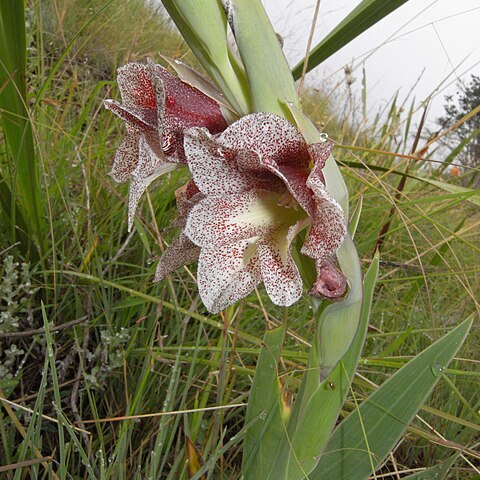Plants 350-1000 mm high, with puberulous cataphylls. Corm depressed-globose, 25-35 mm diam., tunics firm-papery to leathery, decaying into vertical fibrous strips, usually drawn into stiff points above. Stem straight and erect, occasionally branched, sparsely pubescent where not sheathed by leaves, or smooth. Leaves 5 to 7, lower 4 or 5 basal, reaching to base of spike or much exceeding it, villous to microscopically pubescent on sheaths and blades, sometimes sparsely so on lower parts of leaves, or entirely smooth, narrowly sword-shaped to linear, 3-16 mm wide, margins, main and often 1 or more secondary vein pairs moderately to strongly thickened and hyaline, cauline leaves much shorter, uppermost entirely sheathing. Spike 2-ranked, erect and straight, rachis sometimes pubescent, 12-to 20(40)-flowered; bracts pale green and soft-textured, becoming membranous toward apices, usually dry and pale in upper 5 mm, ± inflated and pleated below, villous to minutely pubescent or smooth, 15-30 mm long, acute-attenuate, apices often twisted, inner bracts with margins usually united around base of flower, slightly shorter to slightly longer, forked with attenuate cusps 2-4 mm long. Flowers greenish to cream-coloured, pink, pale lilac, or dull brownish red, tepals unicoloured or minutely dotted with dark red to maroon, often more densely along midlines, lower laterals or all lower tepals yellow-green in basal half or with darker spade-shaped markings distally, unscented; perianth tube obliquely funnel-shaped, widening and curving outward near apex, 10-16 mm long, extended between bracts; tepals with dorsal longest, hooded, (18-)25-32 x 12-15 mm, upper lateral tepals directed forward, usually curving outward in upper 1/3, 22-30 x 13-15 mm, lower 3 tepals united for ± 1.5 mm, laterals 16-22 x ± 7 mm, curving outward above, narrowed somewhat below, lower median curving toward ground, 20-25 x 10 mm. Filaments 10-12 mm long, exserted 6-8 mm from tube; anthers 8-10 mm long, reaching distal 1/3 of dorsal tepal, yellow; pollen whitish. Style arching over stamens, dividing between base and upper 1/3 of anthers, branches 4-5 mm long. Capsules obovoid to oblong, 3-lobed and auriculate above, 12-23 mm long. Seeds ovate, 5-7 x ± 4 mm, broadly and evenly winged.
More
Perennial herb, geophyte, 0.5-1.1 m high; corm depressed-globose, tunics firm-papery to coriaceous; stem straight, erect, occasionally branched, pubescent. Leaves 5-7, ensiform to linear, sheaths villous to pubescent, 3-16 mm wide, margins, midribs and secondary veins thickened and hyaline. Bracts pale green, villous to pubescent or smooth, apex membranous, often twisted. Inflorescence a 12-20(-40)-flowered spike, distichous, erect; flowers greenish to cream-coloured, pale lilac or dull red; tepals sometimes minutely dotted; perianth tube obliquely funnel-shaped, widening or recurving outward near apex; tepals unequal, dorsal longest and hooded over stamens. Stamens exserted, yellow; pollen whitish. Ovary narrowly oblong; style arching over stamens. Flowering time Feb.-Apr. Capsule obovoid to oblong, apex 3-lobed, auriculate above.

